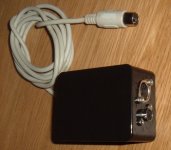How eerily appropriate... my 100th and 200th post have both been in this thread... I was busy on here the past month lmao!
Thought I'd give an update... I sent my Gerber files to a small scale PCB manufacturer, and got them back about 2 weeks ago. Before I placed an order, I made sure to correct a set of holes which were too small for the through-hole component (DIN5 connector)... turns out I STILL sent the old set of Gerber files with the too-small holes to the manufacturer anyway... great...
So before I release my Gerber files and final source code (just clean up the source tree), I need to drill some holes and make them bigger, as well as jumper a trace I may break through during drilling. I also need to make sure the Gerber files are CORRECT this time! I think I'll also add a PS/2 connector.
I'd like to take this time to explain... although this is a fun project, and I'm putting up my code/Gerber files for those who are interested, I will readily admit that Chuck's implementation is superior. Because he used a 5-volt tolerant PIC, and I only used a 3.3-volt compatible MSP430, his implementation needs fewer external components... and as I've found out, surface-mount capacitors are surprisingly expensive o.0;. The only advantage that I can think of mine offhand is that getting a cheap programmer (Launchpad- cost $4.30 plus time to set up software) to DIY is trivial.
Like Chuck's AT2XT implementation I believe, you need to connect the converter to a male-to-male DIN5 cable and connect the end of the cable to the PC.
Thought I'd give an update... I sent my Gerber files to a small scale PCB manufacturer, and got them back about 2 weeks ago. Before I placed an order, I made sure to correct a set of holes which were too small for the through-hole component (DIN5 connector)... turns out I STILL sent the old set of Gerber files with the too-small holes to the manufacturer anyway... great...
So before I release my Gerber files and final source code (just clean up the source tree), I need to drill some holes and make them bigger, as well as jumper a trace I may break through during drilling. I also need to make sure the Gerber files are CORRECT this time! I think I'll also add a PS/2 connector.
I'd like to take this time to explain... although this is a fun project, and I'm putting up my code/Gerber files for those who are interested, I will readily admit that Chuck's implementation is superior. Because he used a 5-volt tolerant PIC, and I only used a 3.3-volt compatible MSP430, his implementation needs fewer external components... and as I've found out, surface-mount capacitors are surprisingly expensive o.0;. The only advantage that I can think of mine offhand is that getting a cheap programmer (Launchpad- cost $4.30 plus time to set up software) to DIY is trivial.
Like Chuck's AT2XT implementation I believe, you need to connect the converter to a male-to-male DIN5 cable and connect the end of the cable to the PC.

